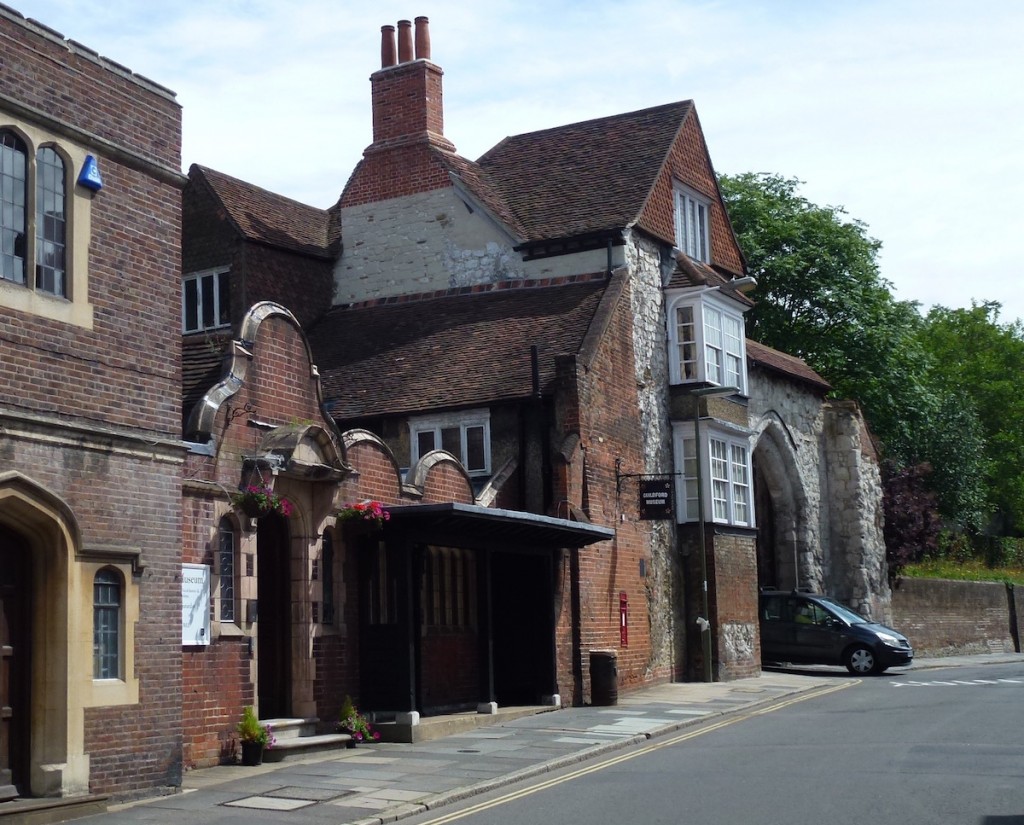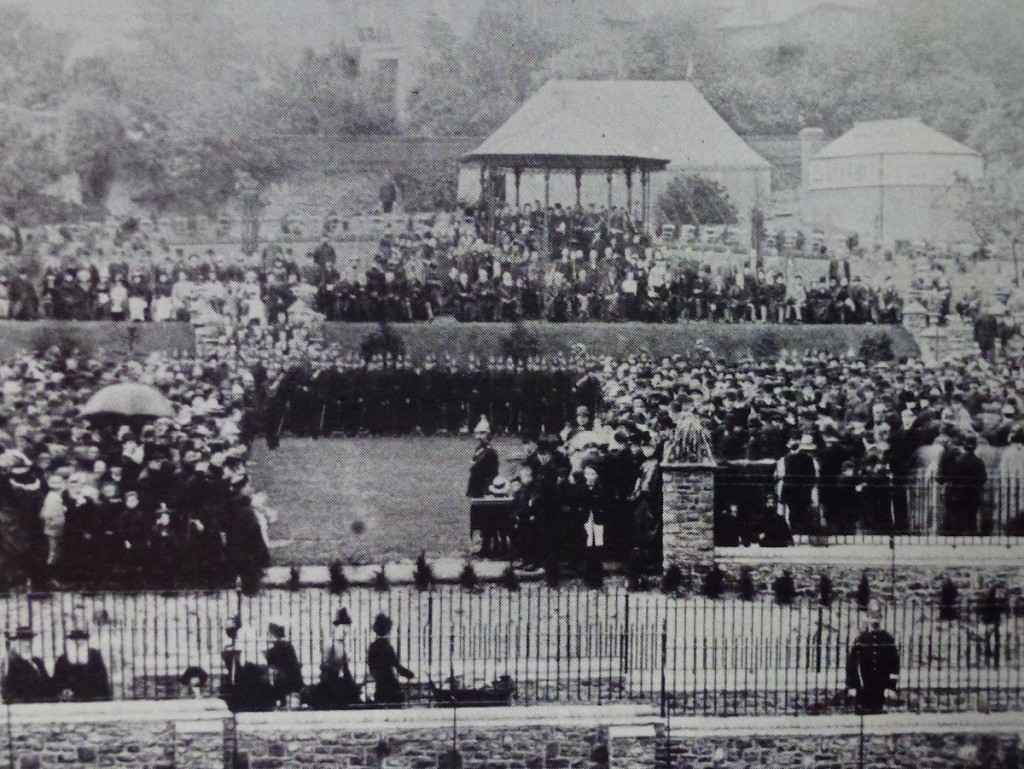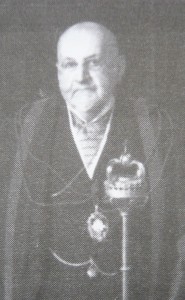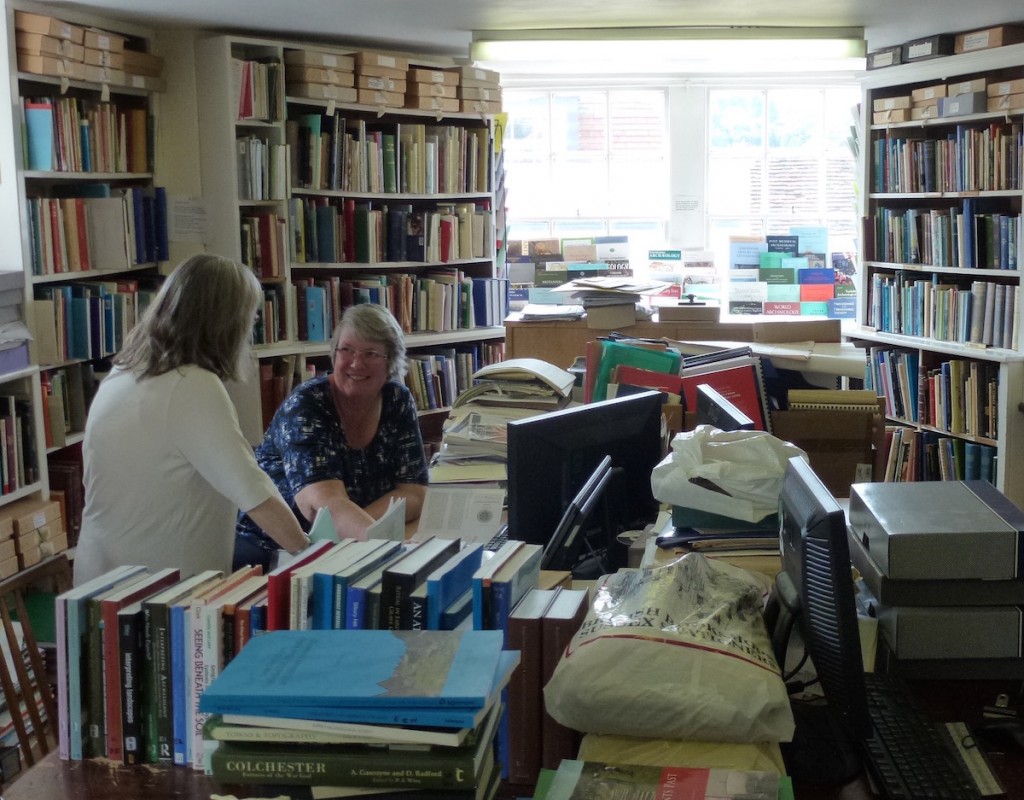 Abraham Lincoln
If given the truth, the people can be depended upon to meet any national crisis...
Abraham Lincoln
If given the truth, the people can be depended upon to meet any national crisis...
 Guildford news...
for Guildford people, brought to you by Guildford reporters - Guildford's own news service
Guildford news...
for Guildford people, brought to you by Guildford reporters - Guildford's own news service
The History of Guildford Museum and the Surrey Archaeological Society
Published on: 19 Aug, 2015
Updated on: 19 Aug, 2015
Guildford Museum began with the idea of founding a county archaeological society for Surrey, in 1852. The number of similar societies had been growing since the 1830s, when the subject of archaeology was developing, helped by the growing understanding of the great age of the earth through geological discoveries, and the realisation that human history was therefore very much older than had been thought.
It was starting to be possible to see a sequence. The three ages of stone, bronze and iron had been worked out and the earthworks visible everywhere were being slotted into it.
Archaeology included many things: ‘primeval antiquities’, architecture, sculpture, painting on walls, wood and glass, manorial rights, heraldry, genealogy, costume, coins, and documents. It was the aim of the society to collect and publish information on all of these topics and more.
The Surrey Archaeological Society (SAS) was started by George Bish Webb, FRIBA, an architect in Covent Garden, in 1852, though its history is usually dated from the inaugural meeting in 1854. But in 1852 it already had six vice-presidents (but no president) and a committee of eighteen gentlemen, all with the word ‘esquire’ after their name, except for the three clergy and an “honourable”.
The meeting in 1854 was held at the Bridge House Hotel in Southwark: only just in Surrey. There had been an idea to make it a society for Surrey and Middlesex, which may account for the number of London-oriented members. The vast majority of members in the early days came from London, or its suburbs in north-east Surrey: Pimlico, Clapham, Streatham, Merton, Carshalton, Southwark. Not many came from Guildford, or west Surrey.
By 1858 there were about 500 members, thirty three of whom lived in and around Guildford. There were 18 honorary members, including some leading lights in archaeology, history, and heraldry, such as the director and the secretary of the Society of Antiquaries, the keeper of antiquities at the British Museum, and rouge croix pursuivant at arms of the Heralds’ College.
The Archbishop of Canterbury, with residences in Lambeth and Addington in Surrey, was a life member, as was Lord Abinger of Abinger Hall. The Duke of Buccleuch, of Whitehall and Richmond, Lord Lovelace of East Horsley and a handful of other noblemen who happened to live in Surrey added tone to the membership.
As with the 1852 committee the vast majority were gentlemen or ‘esquires’, with a few clergymen. Some of the gentlemen were in a profession such as medicine, the law or architecture. There were a handful of women members. One was the wife of a member, most were married women joining on their own and there were two unmarried ladies.
Men who applied to join the society were voted for (or against) by the other members. Ladies were admitted without a ballot. The annual subscription was ten shillings. Discussion on religion or politics was forbidden at meetings.
The first annual general meeting was held a few weeks after the inaugural meeting, at Kingston, with 150 members and friends. In 1855 they met at Chertsey and later that year at Guildford. On both occasions 120 people sat down for a ‘cold collation’ after the meeting. Meetings continued to be held in different towns, starting with talks on local and general subjects. At Kingston they included the Kingston coronation stone, and ancient fonts in England.
In Chertsey the three talks were all about the Abbey, which had just been excavated, using workmen to do the digging. Temporary museums were put together for these meetings, mainly by local members, but the society’s museum collection was mentioned for the first time at the Guildford meeting in 1855, along with their library. It was at Guildford that the idea of including Middlesex was proposed, and adjourned for a year after some opposition. Clearly Surrey was thought to be very closely linked to London.
At Guildford Mr. Butterworth’s collection given to the society’s museum was described as being ‘of extreme local interest, having been discovered in London and Southwark’. It was not until 1861 that Middlesex was mentioned again, by which time there was a London and Middlesex Archaeological Society (LAMAS), founded in 1855.
Surrey members attended LAMAS talks, but the council noted that there was no intention to join with them in any other way. It must have been a controversial subject. There had also been a proposal to include Kent, which was also rejected when the Kent Archaeological Society was formed in 1857.
The Guildford meeting was introduced by W. J. Evelyn, who praised the historical nature of the county town, and remarked, to applause, that the aim of archaeologists was not just to study the objects, but to learn from them about the past life of our ancestors, and to understand the present day, which is still one of the reasons for studying archaeology – to make sense of where we are now.
After a paper on monumental brasses the members moved from the Public Hall in North Street to the castle, then part of the garden of Castle House in Quarry Street, and to St. Mary’s church. In the evening there was a conversazione in the Public Hall, where the temporary museum was examined and the band of the 2nd Surrey Royal Militia ‘enlivened the proceedings’.
This pattern of meetings around the county continued, and the museum collection grew. It was housed with the secretary of the society. In 1872 a permanent home was found with the Croydon Literary and Scientific Institution but this was not a success. A catalogue should have been made but was not, hardly any new objects were added and where were problems about broken cases. In 1860 the auditors suggested having a catalogue of the library and museum, but this was not done for about sixty years.
In 1877 there was discussion about a county museum where the collection could have a permanent home, and be properly developed. Nothing happened, but in 1885 Guildford Corporation bought the castle estate and the society hinted to them that they might move their museum there.
G. C. Williamson of Guildford, a member of the society, encouraged this and in 1888 it was agreed, but Castle Arch house was not available until 1898. The rent was low, and one of the conditions was that the public should be admitted to the society’s museum free, once a week.
The house had been divided into four cottages, and only the west end was used by the society. The large downstairs room was used for displays, and the upstairs for the library.
Many more objects were offered, particularly from Guildford and west Surrey. The annual report for 1897 hoped that the move to Guildford would encourage more members from the area. There were still many from London, but more from west Surrey than in the 1850s.
The early collections were a mixture of old and interesting things from all over the world such as a stuffed alligator, spears from New Zealand and Malaya, and two mummy cases. This reflects the early years of museum collections as ‘cabinets of curiosities’, not simply historical items telling a story.
Although in 1899 it was decided that only objects from Surrey would be collected, finds from elsewhere still got in. Most objects were from Surrey: archaeology and local history, including the early acquisitions from Roman London. They included medieval floor tiles from the excavations at Chertsey Abbey, Roman finds from Chiddingfold and prehistoric flint axes.
In 1900 there were two rooms with displays which included copies of seals from local abbeys or towns, tiles from Waverley Abbey, two medieval jugs found near the Angel inn, Guildford, and broken pottery from a house in the High Street. There was glass from the Wealden glass making sites and a 15th century spur. One case had a mixture of Palaeolithic hand axes from Farnham and Neolithic flint tools and Roman urns from Merrow.
In 1903 Frederick Elsley became librarian and curator, with a small nominal salary. He was there until 1944 and worked hard to organise the collections, helped by members of the society, particularly Miss O. M. Heath who drew up the Museum catalogue.
The new museum encouraged Gertrude Jekyll, the garden designer, to donate her collection of cottage bygones. She had collected these because she saw the old way of life, which she knew as a child in the 1840s and 50s, disappearing as mass-production made new clothes and new furniture and household goods available to the cottagers. She was a pioneer in this type of collecting, and published a book about her collection in 1904 – Old West Surrey.
However, her offer made the society realise it needed a lot more display space. As tenants of the Town Council they could not build on the site themselves, and one of the councillors, Alderman Ferdinand Smallpeice, of an ancient Guildford family, paid for the gallery himself.
It was built on the garden behind Castle Arch, and was not without controversy. It meant knocking down the garden wall running along Quarry Street and some people were opposed to this.

Castle Arch before the museum gallery was built. By the horse and cart can be seen the garden wall that was demolished, with some controversy, to make way for the new museum gallery.
The architect was Ralph Nevill, who did a lot of work in Surrey. He had annoyed the local artistic community by his alterations to the house in 1898. However, the gallery was begun in 1910 and opened on 15th February 1911, by the mayor, William Patrick.
The splendid door includes the date 1910 in the design. The gallery was in an Arts and Crafts-style Dutch-type design, with terracotta details around the door and windows. It is one of only three buildings in Guildford to use terracotta when it was fashionable around 1900.
The intention in moving to Guildford was to have a museum, but not everyone thought that it would be a permanent home. Some thought that the museum would move in a few years, and in 1908 there was some opposition to the new gallery because of the affect it would have on the old house. Architect Hugh Thackeray Turner hoped that the scheme would fall through so that a proper county museum would be built.
It was clearly controversial: some people said the wall to be knocked down was not old, and H. E. Malden of the Society proposed a very carefully worded amendment avoiding any opinion on the wall and saying that they were prepared to ask the architect to keep as much of it as possible, as long as the entrance was made in Quarry Street. In fact, the wall was not kept.
A great depth of garden soil had to be removed to build the new gallery, but the only item recorded was a small, rather crude little medieval jug. Presumably the remains of walls would have been noted, especially as the society had excavated at Waverley Abbey a few years before.
It is likely that the garden of the house was once part of the castle bailey, and it is perhaps surprising that the society did not excavate it before building started. However, medieval archaeology in towns was not recognised for at least another fifty years.

Guildford Museum today with a bus shelter still in place in front of the gallery, a reminder of the times, up until the early 1960s, when Quarry street was the main road from Guildford to Shalford..
A hundred years later it is difficult to imagine Castle Arch without the society and the museum. The society’s museum encouraged the town council to start its own collection in 1905, in case a county museum was built, which would collect, archaeology, natural history, geology, etc.
The town collected mainly local history items. One of the first objects they collected seems to have been the inn sign of the White Hart inn, an almost life-size wood and plaster deer. The inn was demolished in that year, and the sign was given by the architect Ralph Nevill.
After the new gallery had been built the town council became more involved, until it took over the running of the museum in 1933. This was partly because of local government rules about committees and tenants.
In 1928 the needlework collection was added. The museum continues to look after the society’s collections alongside their own collections, and there is a close relationship between the two organisations.
© Mary Alexander, January 2011, revised 2015.
Responses to The History of Guildford Museum and the Surrey Archaeological Society
Leave a Comment Cancel replyPlease see our comments policy. All comments are moderated and may take time to appear.
Recent Articles
- Guildford Institute’s Crowdfunding Project for Accessible Toilet in its New Community and Wellbeing Centre
- Letter: Guildford – Another Opportunity Missed?
- Letter: GBC’s Corporate Strategy – Where Is the Ambition?
- My Memories of John Mayall at a Ground-breaking Gig in Guildford Nearly Six Decades Ago
- Westborough HMO Plans ‘Losing the Heart of the Street’ Says Resident
- College Invests to Boost Surrey’s Economy and Close Digital Skills Gap
- Community Lottery Brings Big Wins for Local Charities
- GBC Housing Plan Promises ‘A Vibrant Urban Neighbourhood’ Near Town Centre
- Hospital Pillows ‘Shortage’ at the Royal Surrey
- Updated: Caravans Set Up Camp at Ash Manor School


Recent Comments
- Ian Macpherson on Updated: Main Guildford to Godalming Road Closed Until August 1
- Sara Tokunaga on GBC Housing Plan Promises ‘A Vibrant Urban Neighbourhood’ Near Town Centre
- Michael Courtnage on Daily Mail Online Reports Guildford Has Highest-paid Council Officer
- Alan Judge on GBC Housing Plan Promises ‘A Vibrant Urban Neighbourhood’ Near Town Centre
- John Perkins on GBC Housing Plan Promises ‘A Vibrant Urban Neighbourhood’ Near Town Centre
- S Collins on GBC Housing Plan Promises ‘A Vibrant Urban Neighbourhood’ Near Town Centre
Search in Site
Media Gallery
Dragon Interview: Local Artist Leaves Her Mark At One of England’s Most Historic Buildings
January 21, 2023 / No Comment / Read MoreDragon Interview: Lib Dem Planning Chair: ‘Current Policy Doesn’t Work for Local People’
January 19, 2023 / No Comment / Read MoreA3 Tunnel in Guildford ‘Necessary’ for New Homes, Says Guildford’s MP
January 10, 2023 / No Comment / Read More‘Madness’ for London Road Scheme to Go Ahead Against ‘Huge Opposition’, Says SCC Leader
January 6, 2023 / No Comment / Read MoreCouncillor’s Son Starts Campaign for More Consultation on North Street Plan
December 30, 2022 / No Comment / Read MoreCounty Council Climbs Down Over London Road Works – Further ‘Engagement’ Period Announced
December 14, 2022 / No Comment / Read MoreDragon Interview: GBC Reaction to the Government’s Expected Decision to Relax Housing Targets
December 7, 2022 / No Comment / Read MoreHow Can Our Town Centre Businesses Recover? Watch the Shop Front Debate
May 18, 2020 / No Comment / Read More














Bernard Parke
August 19, 2015 at 9:10 pm
I understand that the child dressed in white is actually Reginald Patrick the son of mayor at that time and the grandfather of former councillor and mayor, Terence Patrick, who is himself about to be made an hon. alderman in November of this year.